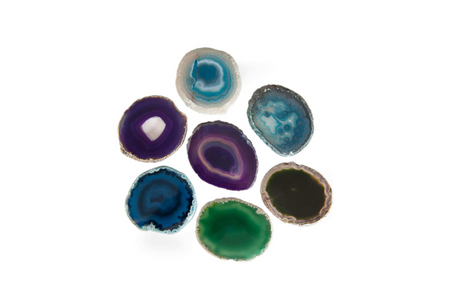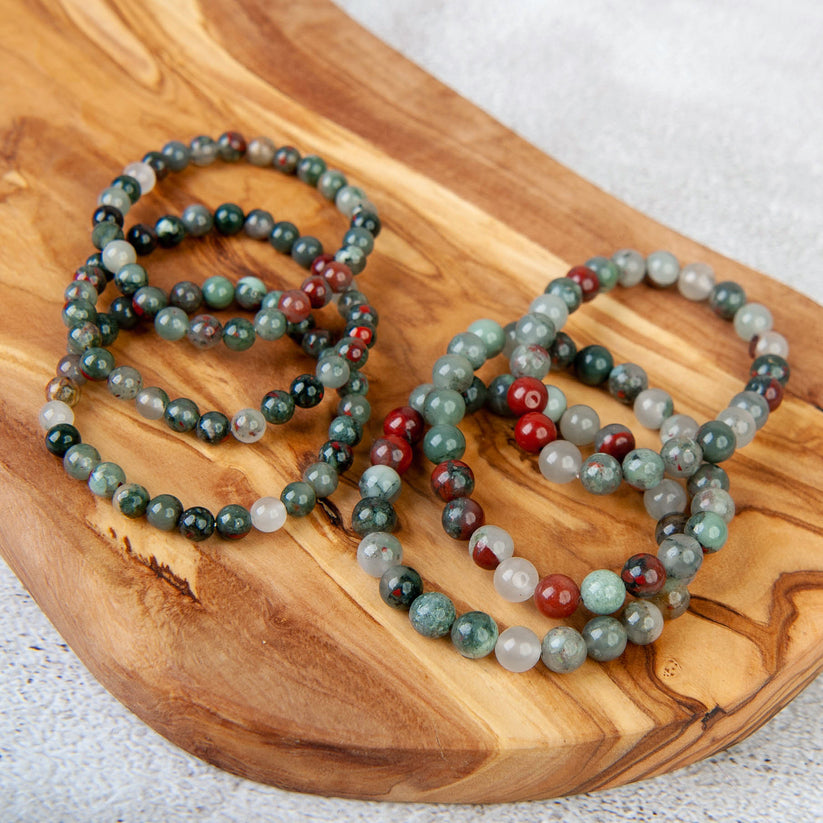The Physical Properties of Minerals
Article by Rezolutions Design
$0.00 USD
Article by Rezolutions Design

In geology and mineralogy, a mineral or mineral species is a naturally occurring inorganic substance with unique chemical properties and definite crystal structure that makes it distinct from other substances.
For a substance to be considered a mineral, it must meet these 5 criteria. It must be:
Naturally occurring (not man-made)
Inorganic (not living and never was alive)
Solid (not gaseous or liquid)
Crystalline (has an orderly, repetitive arrangement of atoms)
Have a specific chemical composition
Identifying an "Unknown Mineral" is like solving a puzzle - each mineral has specific physical properties that must be observed, noted, and compared to known minerals in order to determine its identity.
These physical properties are determined by the crystal chemistry and atomic structure of the mineral. With over 4000 minerals known to man, it may seem overwhelming to try to remember all the characteristics and properties of each mineral, but the more you practice, the easier it becomes.
We typically use the following physical properties to distinguish and identify minerals:
Luster
Streak
Hardness
Cleavage and Fracture
Crystal form or habit
Specific gravity
Colour
Diaphaneity or Transparency
Let's learn about these properties and how they can help us to identify minerals.
A mineral's luster is the overall sheen of its surface and is used to describe how light is reflected from the surface. The sheen of a mineral can be described as metallic, nonmetallic, greasy, silky, vitreous, adamantine, pearly, or dull.
Metallic luster: Looks like a polished metal
Submetallic luster: Duller than metallic, but still slightly reflective
Nonmetallic luster: Resembles glass, wax, or dull clay
Adamantine luster: High shine and sparkly like a diamond
Pearly luster: Has an iridescent or opalescent sheen
Vitreous luster: Looks like a glass
Silky luster: Has a fibrous, hairlike look similar to silk
Dull or earthy luster: Has a very low reflectance
Greasy/oily: Has a waxy feel
Resinous Luster: This looks like coniferous tree resin.
Getting the luster right is perhaps the most important step for determining the identity of a mineral. It's therefore super important to get it right if you're going to identify your mystery mineral.
The streak of a mineral is the color of its powder when it is rubbed against an unglazed porcelain plate. It is usually a more reliable indicator of the mineral's identity than its color, especially when the same sample has a variable color. While most minerals have a white streak, some can have streaks of other colors, including yellow, red, blue, black, and green. Gold, platinum, and copper in particular can be easily identified by their streak when rubbed on a black streak plate.
The hardness of a mineral is its resistance to abrasion or scratching. It is usually tested by scratching its surface with a metal or mineral of known hardness. The scale used to measure hardness is called the Mohs Scale and ranges from 1-10, with 1 being the softest and 10 being the hardest.
Here are some common minerals and readily available materials used to test hardness:
Talc (H=1)
Gypsum (H=2)
Fingernail (H=2.5)
Calcite (H=3)
Fluorite (H=4)
Apatite (H=5)
Pocket Knife (H=5+)
Window Glass (H=5.5)
Feldspar (H=6)
Steel file (H=6.5)
Quartz (H=7)
Topaz (H=8)
Corundum (H=9)
Diamond (H=10)
Scratch the surface of the "Unknown Mineral" with each of the minerals and materials listed above from softest to hardest. If it is scratched by a particular mineral and not by any of the softer minerals, then you know its hardness. For instance, any mineral with a hardness greater than 7 on the Mohs Scale can scratch quartz, and any mineral with a hardness less than 7 will be scratched by quartz.
For starters, buying a hardness kit may not always be necessary, as you can use everyday items to test hardness. A piece of glass, a penny, a pocket knife, a steel file, and your fingernail are all great tools for testing hardness. Sometimes, hardness tests take several tries to get right, so be patient and don't give up!
While hardness is a measure of a mineral's resistance to abrasion or scratching, cleavage and fracture are a measure of a mineral's resistance to breakage. Cleavage is the tendency of a mineral to break along certain planes or angles due to the atomic structure of the mineral, while fracture is the way a mineral breaks when it is not cleaving. While some minerals have a single or two cleavage directions, others can have multiple cleavages, which makes them easier to identify.
The crystal form of a mineral refers to the shape and size of its crystals. This is another important aspect to consider when identifying a mineral. Different minerals can have different crystal habits and shapes, so being familiar with them is key in determining the identity of a mineral.
Some of the most common crystal habits include:
Acicular: Needlelike e.g. Tourmaline
Prismatic: Elongated and flat, e.g. Quartz and Beryl
Blocky: Cube-like or rectangular, e.g. Fluorite
Banded: Alternating layers, e.g. Rhodochrosite and fluorite
Dendritic: Tree-like growths, e.g. Pyrolusite
Botryoidal: Resembling a bunch of grapes, e.g. Hematite
Tabular: Flattened and plate-like e.g. Feldspar, topaz, and corundum
Dodecahedral: Resembles a twelve-sided polyhedron, e.g. Garnet
Equant: Resembles a cube, e.g., Beryl
Columnar/Fibrous: Forms columns or fibers, e.g. Gypsum
Fibrous: Resembles a mass of fine fibers, e.g. Chrysotile
Reniform: Resembles a kidney, e.g., Hematite
Stalactitic: Resembles an icicle, e.g., Calcite
Equant: Four equal faces of a cube or octahedron, e.g., Spinel
The specific gravity of a mineral is its weight compared to the same volume of water. This can be determined by comparing the weight of the mineral to an equal volume of water or by using a specific gravity kit. Specific gravity can provide insight into the composition of a mineral and can be used to identify it.
Most minerals have a distinct color that can aid in their identification. However, some minerals can occur in a variety of colors, so this may not always be an accurate way to identify them. Also, some minerals can have the same color but are composed of different elements. That's why it's important to observe all other physical properties before looking at their color.
Diaphaneity is a measure of how much light can pass through the mineral when it is held up against a light source. The diaphaneity of a mineral can range from transparent to opaque. A mineral is considered transparent if it allows light to pass through it, while an opaque mineral does not allow any light to pass through it.
To distinguish between translucent and opaque minerals, hold the mineral in a strong beam of light and observe how much light passes through it. If a lot of light passes through, then the mineral is considered transparent, while if very little light passes through, it is considered opaque.
These physical properties of minerals can all help in the identification process when you're out rock-hunting or even just studying them in the classroom. Take your time and observe each property carefully to get a better understanding of the mineral.
At Declan's Mining Co. we offer rock hounds with bucketfuls of minerals to identify, each with its own unique properties. We believe in bringing the joy of geology and mining to everyone, from the experts to the novices. So head over and grab a bucket of treasures today and see if you can identify them using the physical properties discussed above!
Happy rock hunting!

Sign up now and enjoy a 10% discount on your first purchase. Start your mining adventure today!
Sign up now and enjoy a 10% discount on your first purchase.
Explore
Learn
Explore
Learn
Get In Touch
Sign up now and enjoy a 10% discount on your first purchase.
© 2026 DECLAN'S MINING CO. - ALL RIGHTS RESERVED.
